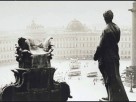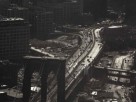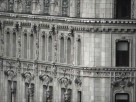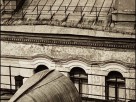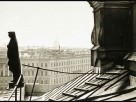Mark Serman Photography Exhibition
Event Venue:
Harriman Institute of Columbia UniversityEvent Date:
TBDThe purpose of the project seems to be serving as an invitation to strictly urban showcase and an attempt to share the hidden beauty with anyone interested in urban history, architecture and photography.
There are animals in the wild that are attracted to elevated spots like eagles and falcons, rams and leopards. Even our house cats love to get up on a wardrobe or a high book shelf so that all their points of compass and approaches are covered. While growing up in Leningrad, I understood that humans are also partial to the heights. All the kids from the building where I lived, myself included, were constantly climbing: up the stairs to the top floors, where the dark and dirty attics sometimes led to an open roof, though usually a great rusty padlock would put an end to trhat exercise. The next best thing was to get on the roofs of the wood sheds that at the time were filling every available spot in the courtyards of the beginning of the 20-th century buildings with dilapidating modern façades and art deco interiors.
As an impressionable young man and an aspiring cameraman/photographer I had had an episode that was as close to the artist’s epiphany as it ever gets, and it was definitely at the point of high elevation. It happened on the roof of the State Hermitage Museum, where our skeleton creative crew was location scouting for a feature film about the museum and its curatorial staff during the Siege of Leningrad. Part of the film was dedicated to the scenes of fire wardens watching for the enemy bombers – a venerable duty of the citizens, performed by the museum staff on the roof of the Hermitage. The roof setting turned out to be something that went well beyond unusual or exotic. It was my first encounter with perfection as I understood it then. The enormous and seemingly endless unevenly ribbed space of the roof itself, that snaked, bent and twisted more than anything Frank Gehry can do; its wide green caterpillar punctuated at many points by blackened bronze and stone figures, chimneys with sooty sculptured decorations, windows, flagstaffs even a small chapel and a guard booth etc…The blindingly bright gorge of the Palace square way down below and the lace of the General Staff Building broken glass dome with a bronze Nike chariot in front…This was the city that I have never seen before, and by a lucky circumstance was placed at the level literally forbidden ( at the time) to all others…To add to that an unusually high key diffused lighting coming from habitually overcast, but bright and sunny on that day sky, with enough haze in the air to turn it into a gigantic photographic light box with diffused shadow-less glow allowing one to shoot in any direction. There was also an element present that turned out to be very important for these notes and the project - the elevation. The elevation of the camera (even to 75-80 feet) in the case of the roof of the Hermitage brought about a new dimension to my whole concept of photographic city landscape. These additional 80 feet extended the skyline upward and deepened the foreground, making the point of view as close to that of a bird or, or a dragonfly or, as I thought then, God…
Several years later, while working at the long defunct now Commercial Studios on Park Avenue South, I finally gained access to the roof of the 22-story building that borders on Gramercy Park, and again the long forgotten feeling of a shift in space visited me. I looked down on the park, the tree tops under me and the people on the paths beyond the trees. The church belfry that narrowed from the steeple down to the even narrower street, and cars like colorful plastic toys, here and there, with even more miniscule people figures amongst them, skylights on the roof of the adjacent building three stories below, looking like huge crystals on a primitive tin ornament. The shift in space and perception was also accompanied by a shift in time. Everything at this level was left alone as it was originally built: the gables, the copper gutters and wall decorations, tiles and windows that are lately being the first to go – all the decorative elements that were so important to architects and the building owners at some point, when the buildings were free standing and anyone could have an uninhibited view of the original beauty. It all changed with the time – the tallest buildings became second tallest and third tallest in the city, in the neighborhood, on the block. This diminishing role of each building inadvertently preserved elevated and thus hidden décor and harmony, the buildings shading each other and keeping their secrets up high, while down below every square inch of the first two or three stories was being changed beyond recognition.
It is not easy to see a skyscraper from the street level. It does sound ridiculous, but there is that phenomenon which is most brilliantly illustrated by a Russian proverb: “He who can’t even see the forest from behind the trees.” It is obvious that the proverb points at someone’s mental shortsightedness. But it is true that we see as far, as our mind habitually reaches. The people going into a redwood forest at the first moments can’t see the sequoias for the only reason that the trees are so enormous that they don’t fit the margins of the usual mindset we have about the trees. This phenomenon is exquisitely described up by John Steinbeck in “Travels with Charley…”
A very similar thing happens with the skyscrapers. For millions of people all over the world, skyscrapers were, and always has been the epitome of New York and the whole notion of the New World. For some of the conservative Europeans the high-rises height, size and overall appearance were probably as alien as a greater part of the American culture. Some people, though, like Fritz Lang in “Metropolis” had established one fact that I also happened to observe many years later. Namely that the skyscrapers in their sometimes frivolous eclectics were as close to old European architecture of castles and churches (with very individualistic approach to style) as many of all tower-like edifices were akin to the Tower of Babel. They were erected as high as people dared to build them, probably with a novel and optimistic idea that the sky was the limit.
When, thirty years ago, as a recent émigré, I first came to downtown New York, it was a dark wintry night. Walking along the empty, narrow, curving this and that way streets took all my concentration – I was looking for an address of a film director who made it to a major of the minor leagues by getting the funding for a movie about a ruler, who the director made sure was hated in the West strongly enough for the director to make some money. I was (habitually) “between” the jobs and was sort of willing myself to like the guy and present myself in a most employable way, since I needed the job very much. For a reason, not pertinent to this story I interrupted the interview, using a late night shoot as an excuse, and hurried out. In the street I stopped, took out a cigarette, lit it and looked around. The entrance to the building was bright with lights and shiny with polished brass. There was a concierge in a Captain Flint uniform sitting in a glass booth reading the “Post” and for the whole world looking like an exhibit at the Madame Tussauds’. All around the building was nearly complete emptiness – no people, almost no cars and very little life in general. It suited my mood just fine. An opportunity of a decent paying job was lost, and I was in no rush to get anywhere, home in particular, where I would have to report on the pathetic results of the meeting.
Slowly I walked in an opposite direction to the one I had to go home and all of a sudden I found myself on the a dark river bank, with an extra dark shadow of the bridge over my head, and the constant racket of the cars echoing off the bridge undercarriage. When I turned around to go back, looking at the street juncture, all of a sudden I felt that I was about to enter a mountain ravine, with the swirling darkness and wet fog blowing in my face. Almost against my own will I looked up and saw the mountainous walls of the ravine. Actually these were the walls of the downtown high-rises with the most of their lights off or unseen, red glare of the city at the very far end with icy mist drifting down in waves. I understood something at the moment which I will try to explain. It has less to do with the skyscrapers and more with the people perceptions, expectations and the most dangerous thing for a creative person – a rigid mindset. In general we look upwards very rarely– it is even considered untowardly, may be even hick – you may look dumb looking up, or it may be dangerous – while you are looking up, they pick your pockets clean, etc. One has to set one’s sights lower while walking (to see what one is walking into, especially in New York). One has to look straight ahead, not to stare, but see what is happening around. This street-savvy behavior is very important, but it also makes you totally oblivious of the most interesting and peculiar part of your surroundings which lies well beyond the sight line. And it is here - up and above the lower stories - where the skyscrapers are finally seen as individual buildings and not as random elements of the continuous walls of the urban ravines-like streets.
Getting up on a skyscraper roof or elevated terrace is not unlike going through the looking glass where the time reverts to a point a hundred or more years before, one’s eye is glued to the sights unseen and unexpected visions from the past and present, while one’s mind, completely humbled and awed by this avalanche of new sensations is trying to absorb it all. Standing at the higher elevation of a skyscraper, one could see from there what the building, if it was alive was quietly observing for decades, almost becoming the eyes of the building-being.
It is a great temptation to personify the buildings, to see them as the descendents of pilgrims’ “salt boxes” developed into a WASP-like community of bigger, taller and richer entities, standing above the pedestrian crowd. Unfortunately this metaphor has no grounds – the high-rises were built mostly by the newcomers and nuveau riche of the New World.
New York skyline was photographed for as long as it exists. And when the humanity invented the flying machines, they were used to photograph the urban landscape from above. Nothing though can provide the additional benefit of being up on the roof or a higher floor of the skyscraper, spending the time to frame a shot, to choose the position. It is indeed the very ability of the spectator/artist to stop, if not to go back in time, and concentrate, taking the time and looking at the same part of urban glory – or blight – and absorb the message sent a hundred years ago and quietly emanating non-stop from the copper and stonework of the haze and smog-veiled pyramids of New York skyline.
The deeply embedded in my mind Old World experience with the views from and of the urban heights and the recent, even more spectacular encounters with New York City skyline prompted me to write these remarks as a presentation for a possible show of photographic impressions of the phenomenon described.
Mark Serman
